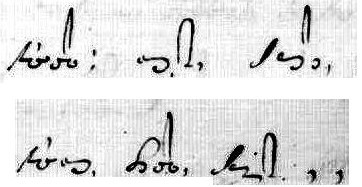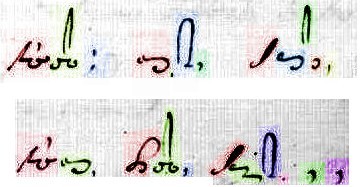Here’s news of a cipher mystery sent my way by generous Spanish blogger Eloy Caballero (who I enjoyed talking with at the Voynich Centenary conference in Frascati). Biblioteca Nacional de Madrid MSS/994 is “Memorial de los servicios prestados a los Reyes Felipe II y Felipe III por D. Luis Valle de la Zerda, correspondencia y documentos del mismo“. All the description of MSS/994 on p.216 of the general inventory is:-
“8. La cifra que Geronio Sertori milanes ofreció a S. M. por suya, y el Consejó de Estado la cometió para que la viese Luis Valle de la Zerda, el cual mostró al dicho Sertori un papel en que estaba la misma declarada por el al Rey Don Phelippe Segundo [hacía 15 años]” (fol.83 – 91[?]).
Now, Luis Valle de la Cerda (1552[?]-1606) was a courtier who not only had in 1590 reformed the Spanish national finances with the introduction of what was effectively state pawnshops [the ‘Montes de Piedad’, there’s a 2003 book by Anne Dubet on his role in that if you’re interested], but had also been made Cipher Secretary by Philip II: MSS/994 is a collection of a few choice cipher documents and keys collected and copied by him.
So far, so obscure: but what triggered this manuscript’s recent lurch into visibility was a PhD final year project by Sara Gómez Hernández, who transcribed this Sirtori cipher together with a Spanish cipher used when sending back descriptions of mines in India (but for which the cipher key has long been lost), and ran them through the well-known Cryptool online app. Though I might well have misinterpreted her results, her conclusion seems (to me) to be that these aren’t fancy-pants Vigenère polyalphas but rather just monoalphabetic ciphers (though she doesn’t offer anything so useful as a decryption of either, sorry all you armchair treasure hunters!)
Anyway, here’s a tidied-up version of Hernández’s Figure 8, which shows the 27-symbol transcription she settled upon for the Sirtori cipher:-
This yields this transcription:-
AYCLPDEAFGRF3RNFCSPFJPKEPOSLMEJBBNGDKNMMPPJSFPFB3SGDPKJRB3MF39ANLP
ONLPYRSRPFPFNGD2CPSALAUB3OB3KJB3NFNBECPNGANLB3PMNNBRSENF3PNBSJRNG
EDLPKEDGK20KCN4CF3JEESNLODPUPNROZNGF3JNB3BSJZDK5ANPSNPNN6GF3JNRSF3J
JNB3BKIADOCKN4F3SJB3B3SLJNBNF3GNPJPNBF3RNA3DSNANNBDNANBNB3RNSK8NC
PF3LEADUF3B3UNB3FASKSNLD24EAKGAF3NNBSJF3NP555DF3GCPB3JB3AMMPB3KRSL
PNBRSF3NPF3G5ESDF32NBCSKAF3LUKPB3NBOGRKJB3UDF3CP8KNDUPNBNRF3DAGAG
B32B3NBSPR2ANPF3DKNS3RNDFNBKD8F3NFB3UR2PF3GSFFNDP8PJJNBSB3NNBSP23Z
F3NDNS3KL3JF3B3NPNBNSGS3RPDKNAF3KL3PB3KNEDEPNF3XSRF3LPNPLXPF3GB3LDN
BFF3NPL8LNXLSKPB35DF3ZSNR2GALZAF3LKPNNBEPJRPNBKS3EBBBB3YLNGLPJMPMSN
BAPANLRB3ENKPRENANBNBYANB3B3P2DLNBPARPEJB35KF35DANBB32AJKPEPMC8SE
B3SLDF3GAPRYNPJNBDPRF3PNLBBNGEKPNKB3B3RNSLBBB3F3RYNAARPNBNEGKB3NSL
3DRF3XB3PANCPYNGJNBENL
The three pages of ciphertext Hernández includes are (I think) page 85,
page 86, and page 87.
By now, you pretty much all know me well enough to have worked out my first question, which is (of course): do I believe this transcription? Because if you start out by getting the transcription basically wrong, there’s a high chance you’ll have little or no success with all the subsequent stages that stand upon that transcription.
So, let’s look closely at the first line of the second paragraph, not because I’m trying to be difficult but because it’s slightly clearer on the page than the first paragraph. Note that I’ve split it up into two halves to make it fit nicely on the screen:
Can you see the problem yet? What seems to have happened is that nearly all the punctuation-like marks have been discarded in the transcription (and for what reason? None!)… but this is surely a recipe for disaster! 🙁 Look again at my colourized version, and I think you’ll see quite a different text…
Now, only loosely following the key above I would transcribe this not as “YRSRPFPFNGD” (and what’s that all about?) but as “YR; S.E, NS3 YS, JR, NGE. , ,“, which is hugely different. So… am I at all surprised that Cryptool was unable to break such a wobbly transcription? No, sadly I am not. 🙁
And with that, I pass the whole thing over to my esteemed friend Mr Tony Gaffney to transcribe and crack his own way. He’ll see straight through its superficial scribal flourishes, so I suspect this will be right up his street. Go for it, Tony! (And the rest of you try to keep up!) 🙂
PS: incidentally, there’s some online discussion on this here in the Spanish Kriptopolis security blog, but I didn’t notice anything that seemed hugely informative or crackworthy – please feel free to tell me if I’ve missed something big there!


